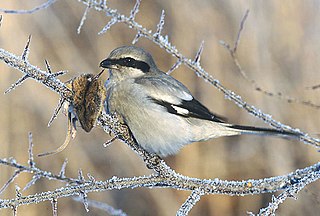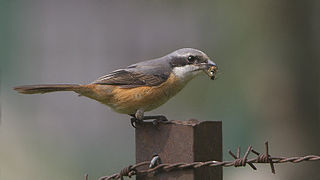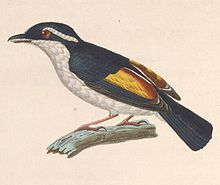
The great grey shrike is a large and predatory songbird species in the shrike family (Laniidae). It forms a superspecies with its parapatric southern relatives, the Iberian grey shrike, the Chinese grey shrike and the American loggerhead shrike. Males and females are similar in plumage, pearly grey above with a black eye-mask and white underparts.

The long-tailed shrike or rufous-backed shrike is a member of the bird family Laniidae, the shrikes. They are found widely distributed across Asia and there are variations in plumage across the range. The species ranges across much of Asia, both on the mainland and the eastern archipelagos. The eastern or Himalayan subspecies, L. s. tricolor, is sometimes called the black-headed shrike. Although there are considerable differences in plumage among the subspecies, they all have a long and narrow black tail, have a black mask and forehead, rufous rump and flanks and a small white patch on the shoulder. It is considered to form a superspecies with the grey-backed shrike which breeds on the Tibetan Plateau.

The brown shrike is a bird in the shrike family that is found mainly in Asia. It is closely related to the red-backed shrike and isabelline shrike. The genus name, Lanius, is derived from the Latin word for "butcher", and some shrikes are also known as "butcher birds" because of their feeding habits. The specific cristatus is Latin for "crested", used in a broader sense than in English. The common English name "shrike" is from Old English scríc, "shriek", referring to the shrill call.

The dark-fronted babbler is an Old World babbler found in the Western Ghats of India and the forests of Sri Lanka. They are small chestnut brown birds with a dark black cap, a whitish underside and pale yellow iris. They forage in flocks in the undergrowth of forests constantly making calls and uttering alarm calls when disturbed.

The bar-winged flycatcher-shrike is a small passerine bird usually placed in the Vangidae. It is found in the forests of tropical southern Asia from the Himalayas and hills of southern India to Indonesia. Mainly insectivorous it is found hunting in the mid-canopy of forests, often joining mixed-species foraging flocks. They perch upright and have a distinctive pattern of black and white, males being more shiny black than the females. In some populations the colour of the back is brownish while others have a dark wash on the underside.

Biswamoy Biswas was an Indian ornithologist who was born in Calcutta, the son of a professor of geology. In 1947, he was awarded a three-year fellowship by Sunderlal Hora, then director of the Zoological Survey of India (ZSI). It enabled him to study at the British Museum, at the Berlin Zoological Museum under Erwin Stresemann and also at the American Museum of Natural History under Ernst Mayr.

The grey-backed shrike is a bird in the family Laniidae inhabiting South-east Asia.
The mountain shrike or grey-capped shrike, is a species of bird in the family Laniidae. It is endemic to the Philippines.

The Himalayan rubythroat is a species of passerine bird in the family Muscicapidae. It is closely related to the Siberian rubythroat which however lacks the distinctive white tail-tips and white tail bases. It was also previously considered conspecific with the Chinese rubythroat, together called the white-tailed rubythroat. It is found along the Himalayan ranges from Afghanistan to Myanmar. Three subspecies are recognized across its wide range.

The pied shrike-babbler is a bird species traditionally considered an aberrant Old World babbler and placed in the family Timaliidae. But as it seems, it belongs to an Asian offshoot of the American vireos and may well belong in the Vireonidae. Indeed, since long it was noted that their habits resemble those of vireos, but this was believed to be the result of convergent evolution.

The shrike-babblers are a group of small birds in the genus Pteruthius. They are native to the Indomalayan realm, and were traditionally placed in the family Timaliidae before molecular phylogenetic studies in 2007 found that they were best considered as belonging to the family Vireonidae which was then thought to be restricted to the New World. They were traditionally classified into five species with several subspecies but changes in the status of these species on the basis of the phylogenetic species concept suggest more forms in a cryptic species complex. Most species are found in montane forests, with some species descending down to lower altitudes during the winter.

The clicking shrike-babbler is a species of bird in the family Vireonidae. It is found from Assam, India, eastern Myanmar to southern China, and southern Vietnam. Its natural habitats are subtropical or tropical moist lowland forests and subtropical or tropical moist montane forests. It used to be considered a subspecies of the chestnut-fronted shrike-babbler.

The trilling shrike-babbler is a species of bird in the family Vireonidae. It is endemic to the island of Java. Its natural habitats are subtropical or tropical moist lowland forests and subtropical or tropical moist montane forests. It used to be considered the nominate subspecies of the chestnut-fronted shrike-babbler.

The white-browed shrike-babbler is a bird species found in the eastern Himalayas and Southeast Asia from northern Burma to southern Cambodia. Like others in the genus it is found in montane forests. Males and females have different plumages and variations occur through its range with several populations being treated as subspecies. It is part of a cryptic species complex and was earlier lumped as a subspecies of the white-browed shrike-babbler. Clements lumps this bird into the white-browed shrike-babbler.

The Dalat shrike-babbler is a bird subspecies traditionally considered an aberrant Old World babbler and placed in the family Timaliidae. But as it seems, it belongs to an Asian offshoot of the American vireos and may well belong in the Vireonidae. Indeed, since long it was noted that their habits resemble those of vireos, but this was believed to be the result of convergent evolution.


















